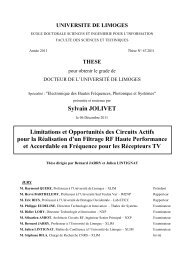Etude de nouvelles stratégies de valorisation de mono et ...
Etude de nouvelles stratégies de valorisation de mono et ...
Etude de nouvelles stratégies de valorisation de mono et ...
You also want an ePaper? Increase the reach of your titles
YUMPU automatically turns print PDFs into web optimized ePapers that Google loves.
Synthèse du 1,20-bis-eicosyl(4’(9-décénylcarbamoyl))-β-<br />
VII.27<br />
(15b)<br />
D-galactopyranosi<strong>de</strong><br />
HO<br />
O<br />
O<br />
178<br />
NH<br />
OH<br />
O<br />
OH<br />
O<br />
Le 1,20-bis-eicosyl-(2’,3’,6’-tri-O-benzoyl,4’(9-décénylcarbamoyl))-β-Dgalactopyranosi<strong>de</strong><br />
(0,11 g ; 0,07 mmol) est dissous dans 2 mL (0,1 mmol ; 14 éq) d’une solution<br />
à 0,5 M <strong>de</strong> méthanolate <strong>de</strong> sodium dans du méthanol. On ajoute 1 mL <strong>de</strong> dichlorométhane pour<br />
favoriser la dissolution. On laisse réagir 16 h puis on arrête la réaction par ajout <strong>de</strong> résine H + , on<br />
filtre <strong>et</strong> on évapore. On purifie sur colonne <strong>de</strong> silice, éluant : le chloroforme/éthanol 90/10 puis<br />
80/20. On obtient 0,03 g (Rdt = 44%) d’un soli<strong>de</strong> blanc.<br />
• Rf = 0,37 (chloroforme/éthanol 80/20).<br />
• Tf = 90°C<br />
20°<br />
• [α]D = 23,8° (CHCl3/MeOH 5/5, c = 0,29).<br />
• IR : 3434 cm -1 (NH <strong>et</strong> OH) ; 3080 cm -1 (CH=CH2) ; 2920 cm -1 (CH3) ; 2849 cm -1 (CH2) ;<br />
1726 cm -1 (C=O) ; 1642 cm -1 (C=O + liaisonH).<br />
• RMN 1 H : 5,81 (m, 2 H) H-9’’, 4,95 (m, 4 H) H-10’’, 4,28 (m, 4 H) H-6’, 4,21 (d, 2 H, J =<br />
7,12 Hz) H-1’, 3,88 (dt, 2 H, J = 6,96 ; 9,40 Hz) H-1a, 3,84 (<strong>de</strong>, 2 H, J = 2,40 Hz) H-4’, 3,65<br />
(m, 2 H) H-5’, 3,53 (m, 6 H) H-2’, H-3’ <strong>et</strong> H-1b, 3,13 (t, 4 H, J = 7,08 Hz) H-8’’, 2,04 (q,<br />
4 H, J = 6,84 Hz) H-1’’, 1,62 (quint, 4 H, J = 6,88 Hz) H-2, 1,49 (quint, 4 H, J = 6,04 Hz)<br />
H-2’’, 1,26 (m, 52 H) H-3 à H-10 <strong>et</strong> H-3’’ à H-7’’. RMN 13 C : 156,9 carbamate, 139,3 C-9’’,<br />
114,2 C-10’’, 103,3 C-1’, 71,5 <strong>et</strong> 73,4 C-2’ <strong>et</strong> C-3’, 72,7 C-5’, 70,3 C-1, 68,4 C-4’, 63,0<br />
C-6’, 41,1 C-8’’, 33,9 C-1’’, 28 à 30 C-2 à C-10 <strong>et</strong> C-2’’ à C-7’’.<br />
• Masse : 1002 (M+H) + ; 988, 974, 960, 946, 932, 918, 904, 890 perte <strong>de</strong> molécules d’eau ;<br />
803 rupture <strong>de</strong> la liaison C-O 4’ ; 658 (chaîne-cycle-chaîne+2H) + rupture d’une liaison<br />
anomérique <strong>et</strong> formation d’une fonction alcool, 315 (chaîne+3H) + rupture <strong>de</strong> la 2° liaison<br />
anomérique <strong>et</strong> formation d’une fonction alcool ; 344 (chaîne+cycle) + rupture <strong>de</strong> la liaison<br />
anomérique.<br />
O HO<br />
NH<br />
O<br />
O<br />
O<br />
HO<br />
OH
















